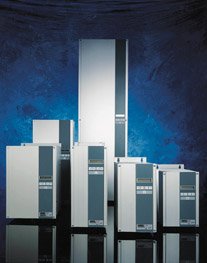Robust, maintenance-free, and even explosion-proof if required, asynchronous motors are widely used for all kinds of drive engineering applications. To ensure optimum control of these motors under any operating conditions, the most suitable one of the various control options provided by the Nordac frequency inverters should be selected.
Dr.-Ing. A. Hermeyer, Dipl.-Ing. W. Foltin
Nordac frequency inverters are available for outputs between 0.25 kW and 132 kW and are used on asynchronous geared motors with integral housings covering a torque range from 10 to 100 000 Nm. The frequency inverters are highly efficient in either of the three major modes through which the motor speed can be controlled.
Frequency-voltage speed adjustment
This method of adjusting the speed of an asynchronous motor through a frequency-to-voltage ratio is used when only moderate demands are made on the stability of speed. The speed n is varied indirectly via the sup-ply frequency of the asynchronous motor which is the actual correcting variable. Speed calculation proceeds according to the following formula:
n = (1-s) • f • 60/(p/2)
where
s is the slip at the nominal working point
(approx. 0.02 to 0.06),
f is the supply frequency and
p the pole number of the asynchronous motor.
As the field-producing current Iµ depends directly on the frequency however, field weakening will occur when the frequency rises while the voltage re-mains constant, and a saturation of the magnetic circuits in the asynchronous motor when the frequency drops.
This systematic deficiency is compensated by varying the voltage in proportion to the frequency in the speed range below the nominal speed. At low frequencies the vol-tage drop at the stator resistor of the asynchronous motor will then be disproportionately greater but can be compensated more or less effectively by boosting the voltage. Torque losses cannot entirely be prevent-ed however, especially in the overload range.
In the range above the nominal frequency it is not possible to raise the volt-age any further. As a consequence the magnetizing current and with it the continuously avail-able torque will drop by the factor 1/f. This is where the so-called region of constant output begins. Some operating conditions may allow for this range to be shifted upwards by the factor 1.73.
No-sensor vectorial control
The ISD type of control which is also termed vectorial control without a sensor almost completely avoids the unfavourable effects described above by providing for a separate control of the field-producing current and the torque in the asynchronous motor (decoupled approach). The working condi-tion of the asynchronous motor is computed by a control system analogue simulator stored in the inverter with only the type plate data of the asynchronous motor having to be entered. No speed feedback (as e.g. from a speed sensor connected to the drive) is required. Still this programme will ensure that the output voltage of the inverter is optimally adjusted to the frequency and the load of the motor. As a result the full amount of the torque will be available even at low frequencies or speeds well into the overload range. This feature is of particular relevance wherever a high torque is required for starting as for instance with agitators.
Feedback control with tachogenerator
For speed monitoring or if a very high precision of speed control is required, a speed feedback control system must be provided (involving e.g. an incremental transducer connected to the motor or to another driving element).
Now another actual value – the speed – is available for processing so that the correcting variables can be calculated even more quickly and precisely. That is why three-phase drives equipped with a tachogenerator feedback system show the same excellent dynamic and static speed characteristics as auto-matically controlled direct current drives while lacking the shortcomings of the latter type. In addition to the various speed control options described above, the Vector inverters provide multiple functions permitting torque control and monitoring.
Getriebebau Nord
Fax: ++49/04532/401253
Further information cpp-250
Unsere Webinar-Empfehlung
Die Websession „Wasserstoff in der Chemie – Anlagen, Komponenten, Dienstleistungen“ (hier als Webcast abrufbar) zeigt technische Lösungen auf, die die Herstellung und Handhabung von Wasserstoff in der chemischen Industrie sicher machen und wirtschaftlich gestalten.
Ob effizienter…
Teilen:











